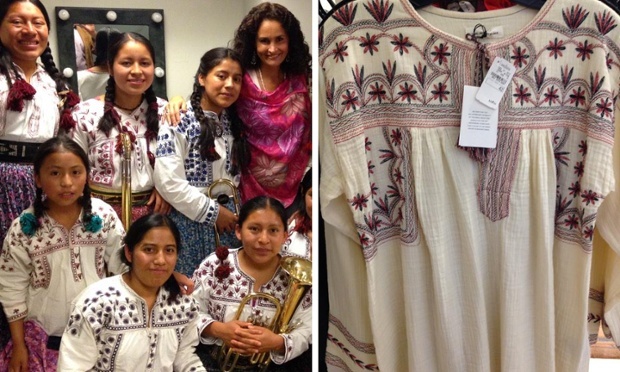Mexican Indigenous Community Considering Legal Action Against French Designer
On Wednesday June 17th, The Yucatan Times published an article stating that Mexican citizens are accusing popular brand TOMS Shoes of copying a traditional “huarache” design. In that article, it was mentioned that French designer Isabel Marant was suspected of profiting from Mexico’s traditional clothing garment design.
And so, a small community of indigenous Mexican women is just about to proceed legally against French fashionista Isabel Marant.
According to British newspaper The Guardian, a blouse from Marant’s Etoile collection has been singled out by the community of Santa Maria Tlahuitoltepec, located in the state of Oaxaca, Mexico; which believes it bears striking resemblance to their traditional costume. In a solemn press conference last week they stated: “Isabel Marant is committing a plagiarism because the Etoile spring-summer 2015 collection contains the graphical elements specific to the Tlahuitoltepec blouse, a design which has transcended borders, and is not a novel creation as is affirmed by the designer.” They are now asking for reparation damages from the designer and are looking into the possibility of taking up legal action.
In January this year, Oaxacan singer Susana Harp tweeted a picture of a blouse from Marant’s Etoile collection beside a picture of the 600-year-old design for the traditional Tlahuitoltepec blouse produced in the south. An image of the two designs went viral with #miblusadetlahui trending on Twitter, and prompted national debate surrounding the issue of cultural appropriation in the fashion industry.
The traditional dress of the indigenous Mixe community in Santa Maria Tlahuitoltepec, Oaxaca, southern Mexico is believed to be a symbol of their identity.
The dress is on sale on fashion site Net-A-Porter for £200, the equivalent of 4,500 Mexican pesos. The original blouse costs around 300 pesos in Tlahuitoltepec.
The Oaxacan people are asking that the heritage of the community is recognised and that Marant removes the blouse from her collection.
Adriana Aguerrebere, of the NGO Impacto, said: “The community also invited her to visit and to learn about the community and the artisan women creating the garment for so many generations … and the community also invited civil society and state, federal and even international authorities to work in the legitimisation of the collective heritage of indigenous peoples.” Impacto will be working with the community to look at broader protections for “the knowledge and the patrimony” of indigenous people.
The debate over cultural appropriation and intellectual property is an ongoing issue in the fashion industry, with numerous instances when Western fashion designers have controversially taken inspiration from cultures around the world.
Victoria’s Secret was forced to apologise after model Karlie Kloss wore a Native American-inspired feathered headdress and very little else on the catwalk at Paris Fashion Week in 2012. A blog representing the rights of native peoples, Native Appropriations, reacted by saying: “This isn’t fun, this isn’t a fantasy character. This is about our cultures, our bodies, and our lives.” The underwear brand replied in a statement they “didn’t mean to offend anyone”.
That same year, the Navajo nation sued Urban Outfitters months after the tribe sent a letter to the high street brand demanding it remove the Navajo name from items, including a hip flask and hipster pants.
Last year designer Paul Smith came under scrutiny after modifying a Peshawari chappal – a leather sandal worn in parts of Pakistan – naming it Robert and adding a price tag of £300 ($476.25 USD), when chappals generally cost less than £15 ($23.81 USD). After a petition, Paul Smith said the shoe was “inspired by the Peshawari chappal”, and has removed the name Robert.
Similarly, the Mixe community are looking to Marant for recognition of their design. They have issued an official declaration calling for the French designer Marant to recognise the imitation of the traditional pattern, and invite her to meet the artisans to “appreciate how the blouse is shared in the everyday”.
The Guardian’s deputy fashion editor Hannah Marriott says: “Legal action, if it were to happen, would be keenly watched by the fashion industry – cultural appropriation comes up again and again in the industry. There’s always such a debate about what’s appropriate, where inspiration ends and plagiarism begins.”
In a further twist to the story, it has emerged that another designer has also laid claim to the design. When the Guardian asked Isabel Marant’s office in Paris for comment on the claims from Mexico, they replied that Isabel Marant had already been “summoned” [sic] by a fashion label called Antik Batik, which believes that they in fact own the copyright on this piece.
Marant’s office stated: “Before the district court of Paris, Isabel Marant is fighting to set the record straight: she has presented submissions which expressly point out that these designs come from the village of Santa Maria Tlahuitoltepec in the province of Oaxaca, in Mexico … Moreover, Ms Isabel Marant, after tracing the true origin of these clothes, officially informed the court: ‘For her part, Ms Isabel Marrant does not claim to be the author of this tunic and these designs’.”
As far as the Guardian can discover, the women of Tlahuitoltepec are not yet aware of Marant’s efforts on their behalf.
